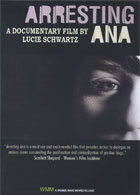
Format: Color, DVD
Arresting Ana is a film that, despite its short running time, grapples with a number of serious and troubling issues concerning the intersections of body image, free speech, and the Internet. The film centers around the pro-anorexia cyber movement, and follows Sarah, an 18 year-old college student with a “pro-Ana” blog called “In Search of Perfection, ” and Valerie Boyer, a legislator seeking to making websites like Sarah’s, illegal. The film describes “Ana” as a way for those struggling with the illness to personify the disease. In the film, Sarah describes “Ana” as a supportive and motivating force and even, a friend. The film depicts both the political and personal sides of this struggle, posing questions concerning free speech, along with the danger and efficacy of such websites. It considers both how these websites function for those suffering from the disease, and also what the impact of the Boyer Law might have on young women like Sarah.
The film, which takes place in France, also deals with how women living in a society so obsessed with food and thinness, might grapple with such opposing pressures. The film is interspersed with images of Paris—of it’s restaurants and markets alongside the advertisements of super-thin fashion models that permeate the country’s visual culture. The film, which focuses on Sarah’s perspective, shows how these websites, whose message can easily be construed as “morbid and perverse,” also serve as communities and outlets for those suffering with eating disorders to connect with others facing similar struggles. However, the film also includes screen shots of these blogs and sites, revealing the troubling imagery and ideology they often seem to promote.
Although the film focuses on the French legislation trying to ban “pro-Ana” websites, which would include up to two-years in prison and a 30,000 Euro fine, it also addresses the universal pervasiveness of this growing trend. As stated in the film, such websites exist in every language and every culture, a fact that underscores the disturbing growth and omnipresence of this disease. By providing the viewer with Sarah’s perspective, the film conveys a more complete sense of how these individuals view themselves, and how these online communities function for individuals struggling with eating disorders and body image.
For further information:
Film’s official website: http://arrestingana.com/
Overbeke, Grace (2008), “Pro-Anorexia Websites: Content, Impact, and
Explanations of Popularity”, The Wesleyan Journal of Psychology 3: 49–62
Norris, Mark L; Boydell, Katherine M; Pinhas, Leora; Katzman, Debra K (2006), “Ana and the internet: A review of pro-anorexia websites”, The International journal of eating disorders 39 (6): 443–447
Morris, Bonnie Rothman (2002-06-23), “A Disturbing Growth Industry: Web Sites That Espouse Anorexia”, New York Times, http://query.nytimes.com/gst/fullpage.html?res=9F00E4DB123CF930A15755C0A9649C8B63&sec=&spon=&pagewanted=all
Harris, Misty (2007-09-15), “Online anorexia videos prompt call for website restrictions”, Edmonton Journal, http://www2.canada.com/edmontonjournal/news/story.html?id=8e8d21e0-c8da-4af1-b05c-01422ab6136d
(in French) Proposition de loi visant à lutter contre les incitations à la recherche d’une maigreur extrême ou à l’anorexie, Assemblée nationale, 2008-07-02, http://www.senat.fr/rap/l07-439/l07-439_mono.html
Schwartz, Lucie (2009-12-22), Outlawing Ana: French lawmakers battle eating disorders (http://www.pbs.org/frontlineworld/rough/2009/12/france.html), PBS Frontline









